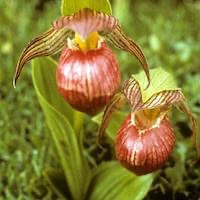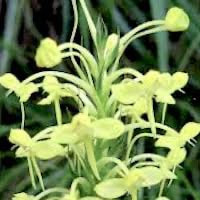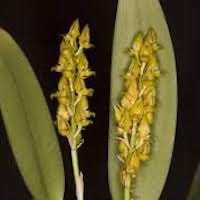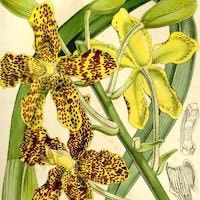MFR12- Men's Fresh 12 - In mint condition
|
Native Singaporean Orchid notes: Rhyncholaeliocattleya Ports of Fortune 'Dragon King'
This orchid has large, fragrant flowers in yellow to chartreuse colors, up to 5 inches wide, with a red blush on the lower part of the lip. It's a hybrid of Rlc (Ports of Paradise x Fortune). Orchids release oxygen at night, making them beneficial in bedrooms for balancing energies while you sleep.
|
Therapeutic Orchid notes:
|
Cypripedium himalaicum Rolfe
Cypripedium himalaicum Rolfe, known as Xiaezhuo Lan (narrow calyx spoon orchid) in Chinese and Gaoshanshao Lan, Khujukpa in Nepali, features fragrant flowers and broad elliptic leaves. Blooming from June to August in Nepal and July in China, it thrives across the western Himalayas. In Traditional Chinese Medicine and Nepal, it treats female infertility, hernias, waist pain, urinary issues, and respiratory ailments. Its widespread presence underscores its value in herbal medicine, particularly for women's health and various medical conditions in the Himalayan region. |
|
Habenaria linguella Lindl.
Habenaria linguella Lindl., known as Poshen in Chinese, is an orchid species found in forests and grasslands across southern China, Hong Kong, and Vietnam, at elevations from 500 to 2500 meters. In traditional herbal medicine, it is valued for its ability to cool "heaty lungs." A decoction made from 9-15 grams of the herb is used to alleviate respiratory conditions caused by excessive heat. Its widespread distribution and medicinal use highlight its importance in traditional medicine, where it is respected for its therapeutic properties in treating respiratory ailments associated with heat imbalance. |
|
Bulbophyllum neilgherrense
Bulbophyllum neilgherrense, an orchid species native to southern India, blooms with striking yellow flowers in February. Found in regions like Malabar and Nilgiri Hills, it is esteemed in traditional medicine for its pseudobulbs, used as a tonic for rejuvenation. These bulb-like structures are believed to possess revitalizing properties, promoting overall health and well-being. The orchid's seasonal flowering and cultural significance underscore its role in local biodiversity and traditional healing practices, highlighting the community's respect for natural sources in promoting holistic health. |
|
Grammatophyllum speciosum Blume
The Tiger Orchid, known by various names across Southeast Asia, thrives in lowland regions spanning Burma, Thailand, Malaysia, Indonesia, and beyond. In Singapore, it blooms from August to September, needing ample growth before annual flowering. Thriving in Penang's dry seasons, it's noted in traditional practices: Thai use the stem for fever and anemia, and roots for insect bites. In Sarawak, the Kelabit eat the slightly bitter "ubud aram" stems. This reflects its cultural and ecological importance, valued for both medicinal use and sustenance in local traditions. |
Other scent note
Scentopia Library Reference ingredient
Ambergris - Check details at Scentopia's scent library
Download the guided mediation that works best with this Orchid fragrance oil
| men_fresh_essential_oil_orchi_00012.mp3 | |
| File Size: | 153172 kb |
| File Type: | mp3 |




